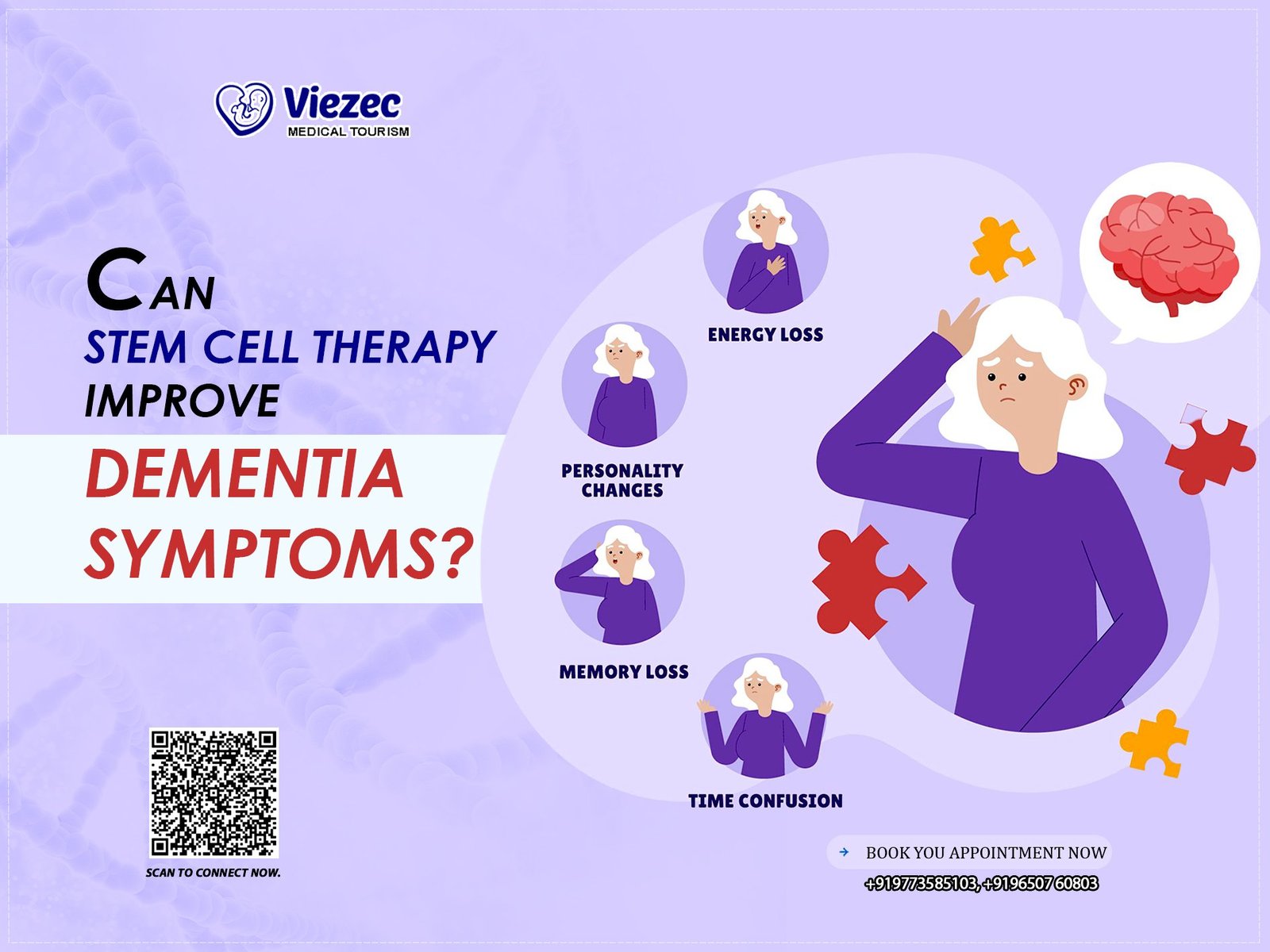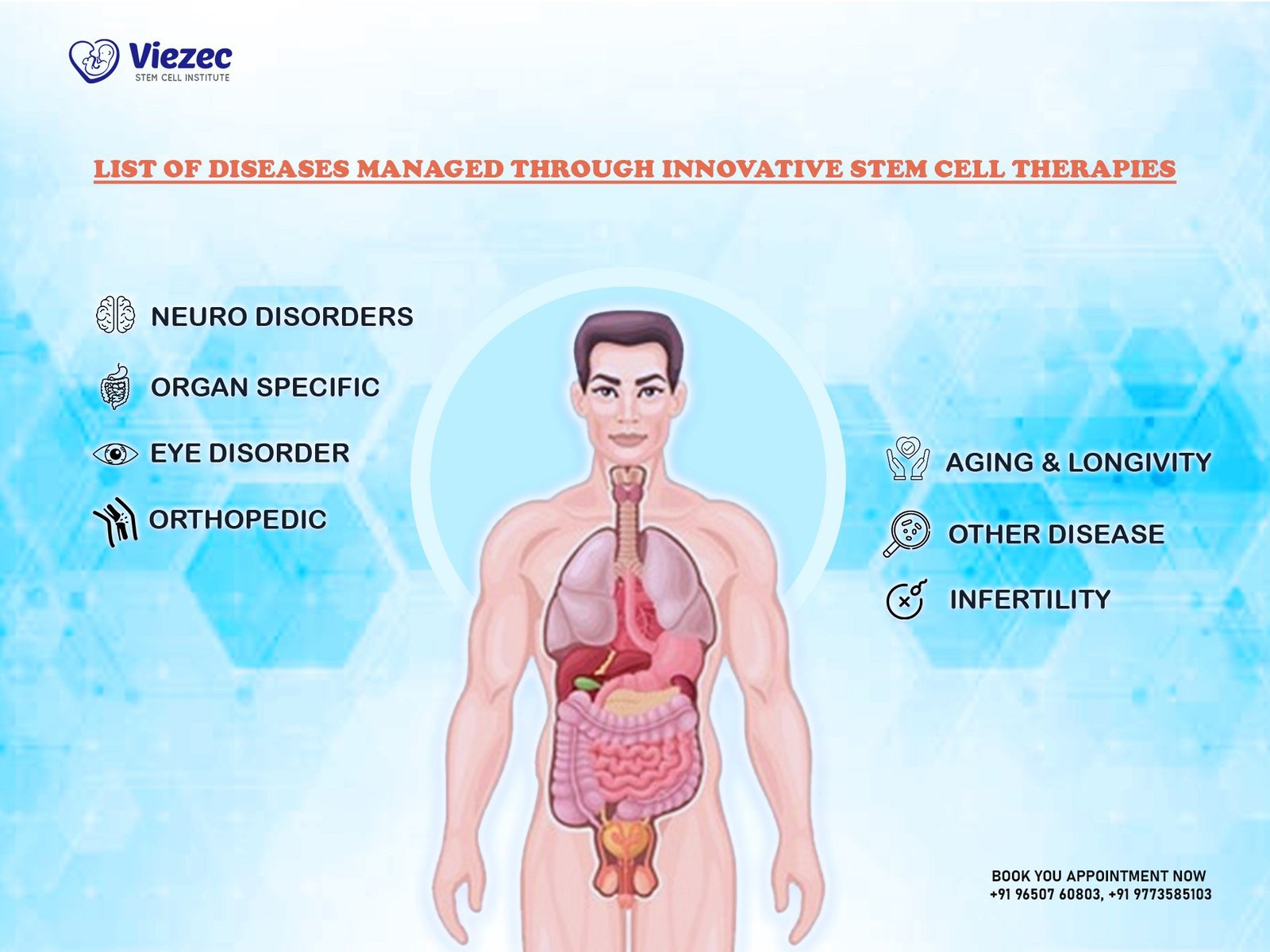Dementia is a debilitating neurodegenerative disorder that affects millions of people worldwide, often leading to a loss of memory, cognitive functions, and independence. As the number of dementia cases continues to rise globally, the urgency for effective treatments grows. Many researchers are seeking innovative therapies to slow, halt, or even reverse the progression of the disease. One promising avenue gaining attention is stem cell therapy for dementia. This treatment has sparked considerable interest due to its potential to regenerate damaged brain tissue. But can stem cell therapy truly improve dementia symptoms? In this article, we will explore how stem cells might offer hope for individuals affected by dementia, the science behind the therapy, and the future of this groundbreaking treatment.
Understanding Dementia: A Complex Neurodegenerative Disorder
What is Dementia?
Dementia is an umbrella term for a range of cognitive impairments that interfere with daily functioning. It is not a specific disease but a collection of symptoms that result from various conditions, most commonly Alzheimer’s disease. The primary symptoms of dementia include memory loss, confusion, impaired judgment, and difficulty with language. There are several types of dementia, each with unique features:
-
Alzheimer’s Disease: The most common form of dementia, characterized by memory loss and confusion.
-
Vascular Dementia: Caused by reduced blood flow to the brain.
-
Lewy Body Dementia: A type of dementia linked to abnormal protein deposits in the brain.
-
Frontotemporal Dementia: Affects the frontal and temporal lobes, leading to personality changes and impaired speech.
The Impact of Dementia on Individuals and Families
The psychological and emotional toll of dementia is immense. As dementia progresses, it robs individuals of their independence and ability to engage with loved ones. Families often experience profound stress, caregivers are stretched thin, and the quality of life for both the patient and their family members deteriorates.
Dementia’s societal costs are staggering. In the United States alone, the Alzheimer’s Association reports that the total cost of dementia care is over $300 billion annually, a figure expected to rise as the population ages. This highlights the urgency of finding effective treatments to slow or stop the progression of the disease.
How Stem Cell Therapy Works: A Regenerative Approach
Basics of Stem Cell Therapy
Stem cells are undifferentiated cells with the remarkable ability to develop into specialized cell types, such as nerve, muscle, or blood cells. This unique property makes stem cells an exciting tool for regenerative medicine, particularly in treating conditions like dementia, where nerve cells in the brain are damaged or lost.
There are various types of stem cells used in therapy:
-
Embryonic Stem Cells: Can differentiate into any cell type and offer potential for extensive brain repair.
-
Adult Stem Cells: Typically sourced from bone marrow, fat, or other tissues, these cells can also differentiate into specialized cells and may be less controversial than embryonic stem cells.
-
Induced Pluripotent Stem Cells (iPSCs): These are reprogrammed adult cells that exhibit similar properties to embryonic stem cells and have shown promise in brain repair.
Mechanisms of Stem Cell Action in the Brain
Stem cells work by replacing damaged or lost cells in the brain, promoting tissue repair, and stimulating the growth of new neural connections. When stem cells are injected into the brain, they can help rebuild areas of the brain that have been affected by dementia. This process, known as neurogenesis, is believed to restore lost cognitive functions, improve memory, and slow the disease’s progression. By encouraging the regeneration of neurons and enhancing the brain’s ability to form new connections, stem cells may help reduce cognitive decline over time. Additionally, stem cells can potentially boost the brain’s capacity for learning and adaptation, improving overall brain health. As more research is conducted, we may uncover even more ways stem cell therapy can enhance the brain’s resilience in the face of neurodegenerative diseases.
The Science Behind Stem Cell Therapy for Dementia
Clinical Trials and Research Studies
Numerous studies have explored the potential of stem cell therapy in treating dementia. A significant body of research suggests that stem cells can help improve memory, cognition, and overall brain function. S
However, these clinical trials have faced challenges, including the risk of side effects, the difficulty in achieving significant improvements, and the need for long-term monitoring. Despite these challenges, stem cell therapy remains a promising area of research, with many experts believing it has the potential to alter the course of dementia in the future.
How Stem Cells Target Brain Cells Affected by Dementia
Stem cells may play a crucial role in repairing brain cells affected by dementia. They have the potential to regenerate lost neurons, enhance neural plasticity (the brain’s ability to form new connections), and even restore some cognitive functions. In theory, stem cells can target specific areas of the brain that have been damaged by dementia, offering a new avenue for reversing or slowing cognitive decline. This regenerative approach could help repair the brain’s structure and function, potentially improving memory and cognitive performance. By stimulating the growth of new brain cells, stem cells may also provide a protective effect against further neuronal damage. As research continues, stem cell therapy could offer a promising treatment option for patients seeking relief from the debilitating effects of dementia.
Types of Stem Cell Therapies Used in Dementia Treatment
Embryonic Stem Cells for Dementia
Embryonic stem cells offer great potential because they can become any type of cell in the body, including brain cells. However, their use is controversial due to ethical concerns surrounding the sourcing of these cells. Despite this, research into their effectiveness for treating cognitive disorders like dementia is ongoing, and the results are promising in terms of their ability to regenerate brain tissue.
Adult Stem Cells in Dementia Treatment
Adult stem cells, especially mesenchymal stem cells, are another type of stem cell used in dementia treatment. These cells are often harvested from the patient’s own body, reducing the risk of immune rejection. Research suggests that adult stem cells may help repair damaged brain tissue and reduce inflammation, making them a viable option for dementia treatment.
Induced Pluripotent Stem Cells (iPSCs) for Dementia
Induced pluripotent stem cells (iPSCs) are adult cells that have been reprogrammed to behave like embryonic stem cells. iPSCs hold great promise for treating dementia because they can be derived from a patient’s own cells, eliminating the risk of immune rejection. Current research into iPSCs for dementia treatment is still in its early stages, but the results so far are promising.
Potential Benefits of Stem Cell Therapy for Dementia
Cognitive Improvement and Memory Restoration
One of the most exciting benefits of stem cell therapy for dementia is the potential for cognitive improvement. Stem cells may be able to repair brain cells and enhance memory function, providing hope for people suffering from memory loss associated with Alzheimer’s disease or other forms of dementia.
Slowing Disease Progression
Stem cell therapy has the potential to slow or even halt the progression of dementia. By repairing damaged brain cells and promoting new growth, stem cells may help stabilize cognitive functions and delay the onset of more severe symptoms, allowing patients to maintain a higher quality of life for longer.
Quality of Life Enhancements for Dementia Patients
Beyond cognitive improvements, stem cell therapy may offer other benefits, such as enhanced daily functioning, emotional well-being, and social engagement. By improving cognitive and physical health, patients may experience an increased sense of independence and well-being. These improvements can help reduce the burden on caregivers, as patients may require less assistance with daily tasks. Additionally, enhanced emotional well-being can lead to a more positive outlook on life, improving the overall quality of care. As patients feel more empowered and connected, their social interactions and relationships may also improve, leading to a better overall experience of living with dementia.
Risks and Limitations of Stem Cell Therapy for Dementia
Ethical Considerations in Stem Cell Use
The use of stem cells in medicine is fraught with ethical questions, particularly when it comes to the sourcing of embryonic stem cells. The debate centers around whether it is acceptable to use embryos for medical purposes, and many researchers are exploring alternatives like adult stem cells and iPSCs.
Safety Concerns and Potential Side Effects
Like any medical treatment, stem cell therapy carries risks. Potential side effects include immune rejection, tumor formation, and the possibility of unintended cell differentiation. These risks must be carefully managed, and patients should be fully informed before undergoing stem cell therapy.
High Costs and Accessibility Issues
Stem cell therapy is not widely available, and the costs associated with treatment can be prohibitive. Insurance coverage for experimental treatments is often limited, making it difficult for many patients to access this potentially life-changing therapy.
What the Future Holds: Advancements in Stem Cell Therapy for Dementia
Emerging Technologies in Stem Cell Therapy
Innovations in stem cell research are paving the way for more effective and accessible treatments for dementia. New techniques, such as gene editing and improved cell delivery methods, could increase the efficacy of stem cell therapy and reduce associated risks.
Collaboration Between Researchers and Healthcare Providers
Collaboration between researchers, healthcare providers, and patients is essential to advancing stem cell therapy for dementia. Continued investment in research and clinical trials will be key to unlocking the full potential of stem cells in treating neurodegenerative diseases.
FAQs
Q1: Can stem cell treatment help with Lewy body dementia?
A1: Stem cell therapy shows promise in slowing progression and improving brain function in Lewy body dementia. However, it is still considered experimental and not widely available.
Q2: Is stem cell therapy available for frontotemporal dementia (FTD)?
A2: Research is ongoing for stem cell use in FTD, aiming to repair damaged neurons and reduce inflammation. Clinical application is limited but may offer future hope.
Q3: How effective is stem cell therapy for neurodegenerative diseases?
A3: Stem cell therapy may support neural regeneration and slow progression in diseases like Alzheimer’s and Parkinson’s. Results vary and depend on disease type and stage.
Q4: Is stem cell therapy covered by insurance?
A4: Most insurance plans do not cover stem cell therapy for neurodegenerative conditions as it’s still considered investigational. Coverage may apply only in approved clinical trials.
Q5: What is the cost of stem cell treatment for dementia?
A5: The cost typically ranges from $5,000 to $25,000 or more depending on the country, clinic, and treatment type. It is usually paid out-of-pocket.
Should You Consider Stem Cell Therapy for Dementia?
Stem cell therapy represents an exciting frontier in the treatment of dementia, offering potential benefits such as cognitive improvement and slowing disease progression. However, it is still an experimental treatment, and risks and costs must be carefully considered. If you or a loved one is considering stem cell therapy for dementia, consult with a healthcare provider to discuss the latest research and available treatment options.
If you’re interested in learning more about stem cell therapy for dementia or exploring treatment options, contact our clinic today for a consultation. Our team of experts is here to guide you through the latest advancements in regenerative medicine and help you make informed decisions about your health.









